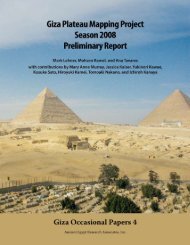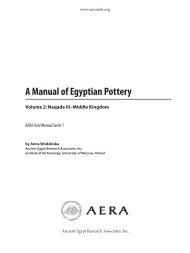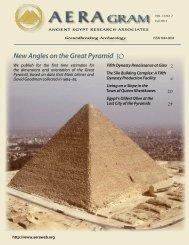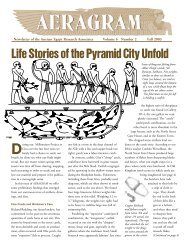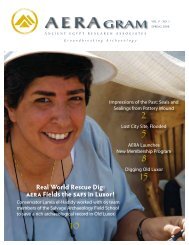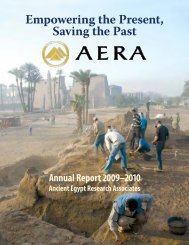Download a PDF of our 2009 Annual Report - Ancient Egypt ...
Download a PDF of our 2009 Annual Report - Ancient Egypt ...
Download a PDF of our 2009 Annual Report - Ancient Egypt ...
Create successful ePaper yourself
Turn your PDF publications into a flip-book with our unique Google optimized e-Paper software.
Charred plant remains under the microscope. From left: lolium grains, seeds <strong>of</strong> mallow (both weeds <strong>of</strong> grain fields), and emmer wheat chaff.<br />
25th or 26th Dynasty. In addition, several <strong>of</strong> the individuals were<br />
buried in c<strong>of</strong>fins. Overall, the c<strong>of</strong>fins in the area <strong>of</strong> the Western<br />
Compound and Chute were generally made with better craftsmanship<br />
than what has been noted elsewhere at HeG.<br />
Pigments<br />
Dr. Laurie Flentye’s main objective in <strong>2009</strong> was to finish analyzing<br />
all the excavated pigments, minerals, and painted plaster<br />
from the RAB, as well as to refine and enlarge the pigment database.<br />
Laurie precisely defines the color using Munsell color<br />
charts, identifies the material, produces a photographic record,<br />
and measures each specimen.<br />
Red hematite and yellow ochre were the most common<br />
pigments from the RAB. The presence <strong>of</strong> querns with hematite<br />
staining suggests that some type <strong>of</strong> pigment production was<br />
taking place there. Most samples <strong>of</strong> painted plaster, primarily<br />
red, came from the earlier structures <strong>of</strong> the RAB.<br />
We identified a number <strong>of</strong> raw materials for pigments in<br />
the mineral samples, which helped complete the inventory <strong>of</strong><br />
pigments from RAB. Having <strong>our</strong> new geologist, Philip LaPorta,<br />
on hand greatly facilitated this line <strong>of</strong> inquiry. Laurie and Philip<br />
will collaborate to find the s<strong>our</strong>ce <strong>of</strong> pigments and identify the<br />
process <strong>of</strong> their production.<br />
Geology<br />
Dr. Philip LaPorta joined <strong>our</strong> Giza Lab team for a week in the<br />
<strong>2009</strong> season. During his brief visit, he managed to analyze<br />
more than 500 objects and specimens recovered from Areas<br />
RAB, BBE, MSE, KKT, and the Chute. More than 100 <strong>of</strong> the items<br />
analyzed were from the RAB.<br />
Philip identified nine broad categories <strong>of</strong> raw materials<br />
used at HeG and KKT. In order <strong>of</strong> abundance, these are: limonite<br />
(used in pigment production), hematites (used as pigments<br />
and a by-product <strong>of</strong> pigment production), limestones (used for<br />
tools and objects), intermediate to ultrabasic igneous rocks<br />
(used for quarry tools and querns), granites (used as a building<br />
stone or for statuary), sandstones (used as abraders and whetstones),<br />
quartzites (used as querns and drill bits), calcites (used<br />
for small vessels, jars, and dishes) and minor minerals (used as<br />
statuary, small jars, plates, beads, and bracelets).<br />
Philip concluded that a foundry or kiln requiring an enormous<br />
quantity <strong>of</strong> quartz sand for casting objects was set up<br />
somewhere near the RAB. He inferred that the RAB must contain<br />
discrete areas for the production <strong>of</strong> pigments and abrasive<br />
materials to polish stone; for processing a considerable quantity<br />
<strong>of</strong> alabaster; and perhaps also for minor bead manufacture. We<br />
find pillow stones, and headrests, used as anvils that would be<br />
perfect for making faience beads, folding thin sheets <strong>of</strong> copper,<br />
possibly working leather sandals, and so on.<br />
While some <strong>of</strong> the raw materials from the site could be<br />
acquired locally, some may have come from as far away as<br />
Aswan. The range <strong>of</strong> raw materials indicates the residents <strong>of</strong> the<br />
Lost City had a deep understanding <strong>of</strong> the mineral res<strong>our</strong>ces<br />
available.<br />
<br />
Stone headrest/anvil from RAB,<br />
approximately 16 centimeters long<br />
(about 6 inches).<br />
The success <strong>of</strong> the <strong>2009</strong> Archaeological Science season is a<br />
credit to <strong>our</strong> interdisciplinary Lab team, who, surrounded by<br />
the imposing Giza Pyramid complex, patiently explore some <strong>of</strong><br />
the most minute and elemental structures <strong>of</strong> daily life at Giza<br />
4,500 years ago. Our collaborative efforts in the Giza Lab also<br />
help keep AERA at the forefront <strong>of</strong> modern archaeology and<br />
archaeological science.<br />
27





